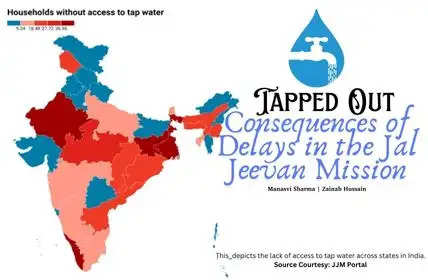Tapped Out: Consequences of Delays in the Jal Jeevan Mission
Academic Project jointly articulated by Manasvi Sharma and Zainab Hussain
The Jal Jeevan Mission was launched by PM Modi on August 15, 2019. As India celebrated its 73rd Independence Day, this mission was launched to provide urgent respite to millions of people across the country, who are struggling to access tap water. Aiming to provide at least 55 litres of water per capita per day to every rural household in India by 2024, this mission has unfortunately not been able to achieve its goal of ensuring “Har Ghar Jal”. As of December 20, 2024, 20.59% of the nation’s rural households await implementation of the program. Among some of the worst performers are Rajasthan, West Bengal, Kerala and Jharkhand, which continue to have more than 45% of the rural households without access to tap water.
Health Cost of the Delay
The delay of the government in implementing this mission has multifaceted implications. Part of the costs of delay in the mission’s implementation come from the loss of the potential positive impact that safe water could have on health. For instance, studies suggest that 100% coverage of the Jal Jeevan Mission could prevent 400,000 diarrheal deaths, save approximately 14 million Disability Adjusted Life Years, and reduce under-five mortality by 30% saving 1,36,000 lives annually. The longer the delay in achieving nationwide coverage, the greater the loss.
Gendered Burdern of Water Scarcity
Beyond the direct effect on health, access to water (or rather lack thereof) also has gendered effects. In areas where houses do not have access to safe tap water, women often travel long distances to meet their basic necessities and survive. According to a World Health Organisation report, women and girls aged 15 and up are largely responsible for water collection in seven out of ten families without on-site water supply. The burden of water collection on their shoulders leaves them little to no time to focus on education and employment. Highlighting the severity of this issue, an article discussing women empowerment through safe water provision states - “Today, women and girls around the world will spend a collective 200 million hours not at school, not at work, and not at home. They will spend it on foot, in pursuit of water”. This harsh reality shows how water scarcity deepens gender inequality, holding women and girls back from opportunities to learn, work, and build better lives. Women and girls face added risks due to their vulnerability to harassment, abuse, and injury when they must leave the house to carry water. Therefore, instead of spending time on education and generating income for the family, women in these area’s are forced to spend significant hours each week to search for water, putting their health and safety at risk. In such circumstances, clean water can not just prevent diseases and improve the health and overall well-being of a person, but also plays a vital role in determining time use patterns of women, in empowering them to develop important aspects of their life holistically and promotes equality of opportunity.
Cost of India’s Future
As of 20 December 2024, approximately 42.0% of the drinking water samples tested by laboratories in Sikkim found contaminants, making Sikkim the state with the poorest water quality in India. This is closely followed by West Bengal at a water contamination rate of 39.5%. Other poor performers in terms of water contamination rates are Puducherry, Andaman & Nicobar Islands, Kerala and Bihar. To take advantage of India’s demographic dividend, it is crucial to acknowledge that the youth today will be our labour force tomorrow. Poor water quality can be severely detrimental to the country’s future because of its direct impact on cognitive and psychosocial outcomes of children. Clean water is a key determinant of a child’s human capital development trajectory and can influence later life socioeconomic outcomes. Therefore, addressing water quality is as important for the success of this mission.
Sustainability, Maintenance and the Way Forward
While the government must strive for a 100% coverage and infrastructure provision, to achieve a long-term impact it should also focus on sustainability and maintenance of “Har Ghar Jal”. Reports suggest that in some areas tap were stolen after installment due to a lack of monitoring. In some areas, despite tap installation, the supply of water was either highly erratic or negligible.
As India stands at the crossroads of immense potential, water scarcity- both in access and quality- is a crucial hurdle we must overcome on the path to Viksit Bharat. The Jal Jeevan Mission requires accelerated and sustained efforts to overcome these challenges and the government must swiftly act on this need of the hour.
DISCLAIMER: The above post comprising of the related facts, assumptions and arguments are of the authors alone and do not reflect the viewpoint of UdaipurTimes.
To join us on Facebook Click Here and Subscribe to UdaipurTimes Broadcast channels on GoogleNews | Telegram | Signal



